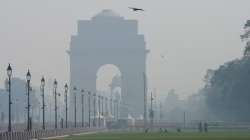Delhi air quality continues to be in 'severe' category as AQI remains over 400 in parts of city
Delhi, one of the world's most polluted cities, is facing extremely hazardous air quality. The Air Quality Index (AQI) has exceeded 400 in several parts of the national capital, and there seems to be no hope for an improvement in the pollution situation.

Delhi air pollution: The air quality in Delhi continued to hover in the 'severe' category on Thursday, with the Air Quality Index (AQI) crossing 400 in several places, as per the Central Pollution Control Board at 8 am. Delhi has been witnessing a steep increase in AQI levels after a marginal improvement on Sunday.
The visibility early in the morning also remained low in the city.
AQI in various parts in Delhi:
- RK Puram: 415
- Alipur: 414
- Anand Vihar: 387
- Ashok Vihar: 386
- Dwarka Sector 8: 412
- IGI T3: 398
- ITO: 343
- Jahangirpuri: 434
- JLN stadium: 382
- Narela: 395
- Najafgarh: 371
- New Moti Bagh: 395
- Okhla Phase-2: 406
- Patparganj: 398
- Punjabi Bagh: 424
- RK Puram: 415
- Rohini: 419
- Shadipur: 331
- Vivek Vihar: 412
- Wazirpur: 422
AQI in Noida:
- Sector 125: 349
- Sector 62: 356
- Sector 1: 334
- Sector 116: 361
According to the meteorological department, there is a possibility of a change in the weather of Delhi-NCR in the next few days. The Central Pollution Control Board (CPCB) has highlighted that Delhi's air quality is currently the most polluted in the country. Delhi ranks first on the global list of the most polluted cities, with three Indian cities—Delhi, Kolkata, and Mumbai—included in it.
An AQI between zero and 50 is considered good, 51 and 100 satisfactory, 101 and 200 moderate, 201 and 300 poor, 301 and 400 very poor, 401 and 450 severe and above 450 severe plus.
The increase in AQI levels comes after the Centre on Saturday (November 18) had removed stringent curbs, including a ban on construction work related to linear projects and the entry of polluting trucks, in Delhi following a drop in pollution levels due to favourable wind speed and direction.
These measures constitute the final stage -- Stage IV -- of the Centre's air pollution control plan called the Graded Response Action Plan (GRAP).